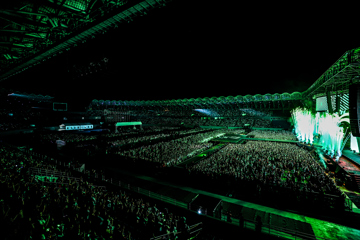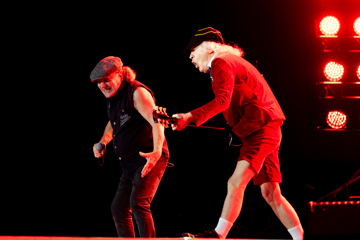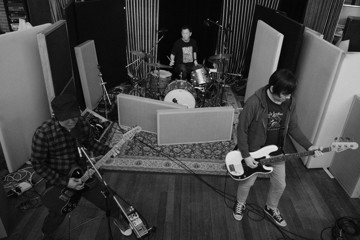Wasted Youth
"A lot of it was like painting: pushing all these neon colours and hues to create this hyper-insane realm."
The prospect was delicious from the first announcement: Harmony Korine, the onetime-crackhead enfant terrible of American underground cinema, was making a film with James celebrity-as-performance-art Franco and Disney tween queens Vanessa Hudgens and Selena Gomez, set against the girls-gone-wild debauchery of spring break. And Spring Breakers delivers on the promise; a brash, obnoxious, semi-ironic flick that plays as a long dream sequence, yet essentially turns MTV's ultra-sexualised culture into a nightmare.
Every Korine film – from Gummo's bacon-taped-to-walls to Trash Humpers' faux-snuff-film trolling – has been an exercise in provocation, but they've done so solely as art-movie curios. Due to its stunt-casting and parade of fresh flesh, Spring Breakers has been a genuine commercial success, being witnessed – and written about – by far more humans. And, thus, received the kind of witless editorials that come with mass exposure, a controversy-mongering The Guardian piece conflating that Spring Breakers glorifies rape culture; even though, as The New Inquiry so sagely retorted, “to accuse Spring Breakers of propagating rape culture is tantamount to accusing Platoon of propagating war.”
In the middle of all this controversy sits Harmony. Now 40, Korine is no longer the young maverick, the prodigy plucked from a life of stoned skating as a teenager by Larry Clark. He's a father, now, and someone who may've just, due to the success of his film, acquired some genuine Hollywood power. Yet Korine is hardly arrogant, or apologetic, or defiant in the midst of all this controversy. Instead, he's just affable; denying any need to defend his film with a shrug. “I don't need to defend the film, it defends itself,” Korine says. “I make the work until I feel like it's perfect in the way that it exists, and then I put it out there.”
How does it sit with him, personally, that Spring Breakers – and he himself – is being called sexist? “I think it's great!” Korine beams, earnestly. “All reactions are perfect. I don't ever make a film that's ever meant to be one way. I can feel one thing, you can feel another thing that's exactly the opposite. Who's to say what's right? I just hope you're moved by them, you're entertained. I'm just trying to make things beautiful.”
Of course, 'beauty' is in the eye of the beholder; the poster for Trash Humpers, after all, infamously showed a man in a horror-store mask sitting on the toilet. Surely Korine must realise – must relish – that his role is as provocateur? “I don't think of myself as a provocateur, because I don't even think of myself!” he laughs. “I follow the light. There's something that's more purpose-driven that I follow... There's certain things in the films that characters do that provoke. But to me it's nice to have things that get a reaction, that make people feel a certain way; that make them confused, or excited, or outraged. But I don't think of them as provocations, I just think of them as little gems.”
The genesis of Spring Breakers came when Korine started collecting “pictures of extreme debauchery on the beaches of Florida”; the excessive behaviour and flagrant bacchanalia of a ritual built on public drunkenness and hyper-sexualised inhibition: photos of college kids making their own porn, vomiting in the ocean, snorting the powdered sugar off donuts, flashing body-parts at passersby. Symbolically, spring break is televised by MTV – its coverage sponsored by various brands of liquor – as rite-of-passage for American kids, the next step on from a 'super' sweet 16 party; presented with a bubblegum façade plastered over a date-rapey culture.
“It's almost this classic iconic American imagery,” Korine offers, “but at the same time there's this collision between this hyper-sexualised, hyper-violent ritual and the teenaged innocence that surrounds it, the pop indicators of youth: the nailpolish, the bathing suits, the Mountain Dew bottles, the kegs. I started seeing it as this coded language, and I wanted to use that language to make a film that was like a pop poem. It was never meant to be a documentary or an exposé of this debauched, immoral world, it's far more an impressionistic portrait of its imagery.”
Wanting the movie to play like a dream, or a “drug trip” at a trance-DJ set, Korine cuts the film up into a “liquid narrative” that swims this way or that, the slipperiness creating a surreal feeling that certainly suggests it's a commentary on fantasy, not reality. Visually, it's a radical aboutface from the grimy pallor of Trash Humpers, which was shot in the dark on decaying VHS tape. Filmed on 35mm and then wildly colour-graded, Spring Breakers' hyper-saturated palette plays a huge part in its detachment from reality. “I wanted the movie to look like it was lit with candies,” Korine enthuses. “I wanted the film to seem like we'd used skittles for lenses. The movie is about cultural surfaces, the way things look and feel. And all the mythology and meaning is the residue of those surfaces, the bleed of the candy. A lot of it was like painting: pushing all these neon colours and hues to create this hyper-insane realm.”
But push Korine on what that abstraction and detachment mean, thematically, and again he defers. “I just try to be a good soldier of cinema,” he says. “It's more instinct to me. I prefer not to say anything about the film definitely, that it's this or that, because I don't want to complete the act, to close the narrative. I make films that are put together in a way that they obviously invite extreme reactions, because they're not telling you what to think. There are things in there that people find morally ambiguous, so they then become more of a reflection of the viewer. To me, that's making a real personal connection with audiences. I want people's reactions to be personal and interpretive, for it to be like an abstract painting: whatever you think is there is there if you believe it.”







